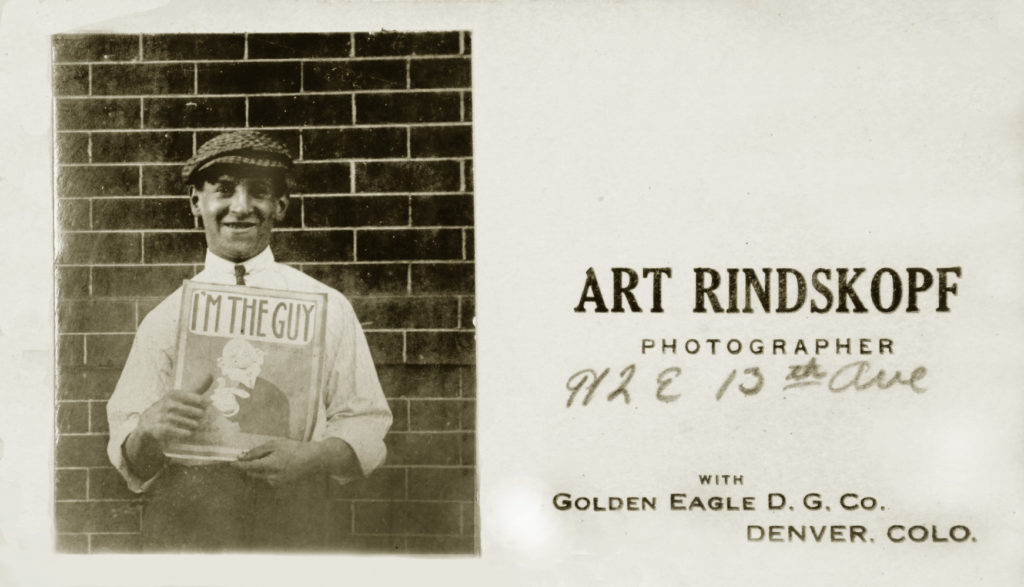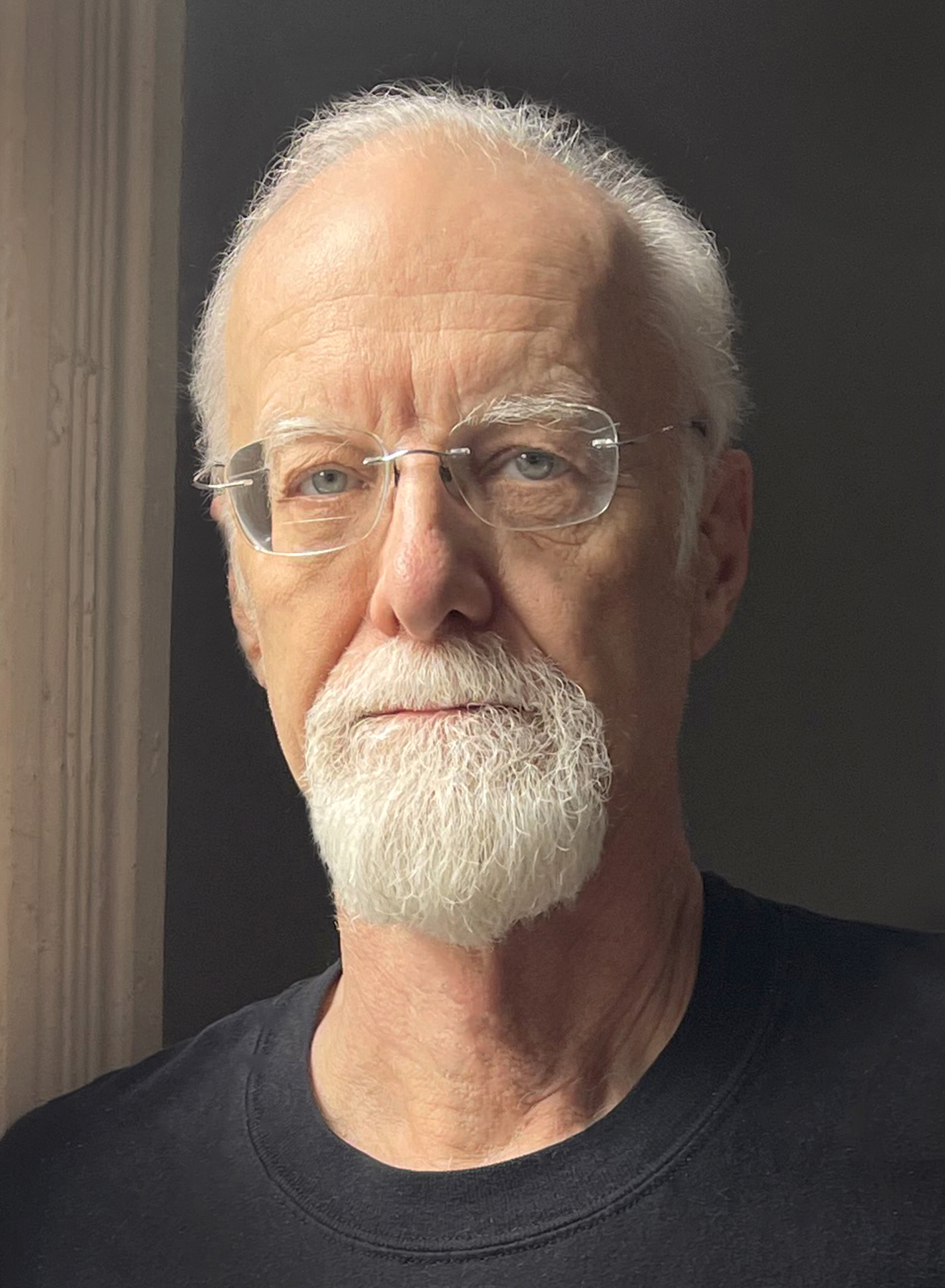My name is Jeremy, and I am an image-oholic. I also have a rescue gene that I share with many collectors and ephemera researchers and curators. Some images I come across get little attention other than a passing glance. But others, unfortunately for me – many others, cause me to pause and start to ask questions like: “What information is hidden in this image?”; “Why was it taken?”; “Why is the subject giving us a ‘thumbs up’ to match the image he holds?”; or “What did the card mean to the subject, photographer, or to the custodians who have held the image since it was made?”
While visiting a fellow image-oholic, I came across this little photo related business card that immediately grabbed my attention. After a variety of apparently persuasive comments and offers, I was able to bring the little card home with me. Then began the process of uncovering at least a part of its embedded story by exploring the printed information and pencil notation on its front as well as the information contained in the original photograph that had been pasted onto the card. Sadly, the back of the card was blank and offered no useful clues.

My first impression of the image was that it probably dated from the ‘teens based on the type of photographic paper used and style of clothing. The identification of “Art Rindskopf Photographer” was an instant draw. An initial simple search did not provide any useful information even when targeting the early 20th century and specifying Denver, Colorado. The search did, however, lead me to an interesting bit of trivia about the card itself that was strangely not shared by my collecting friend. The card was sold in a recent auction of San Francisco collector Ken Prag’s collection that I sadly missed. I knew Ken, and first met him in the 1980s at the California Camera and Photographic shows. Over the years, he was the source of many very expensive, but highly treasured images now in my collection. He never showed me this little business card.
Looking into the “Golden Eagle D.G. Co.” on the bottom of the card was a next step. I initially thought D. G. could be a drugstore, but soon found that it was actually an abbreviation for Dry Goods. Using that clue, I learned that the Golden Eagle Dry Goods Company had originally been established in Leadville, Colorado by an 18-year-old Bavarian, Leopold Henry Guldman, and some fellow miners in the late 1870s. By 1883, Leopold had moved the business to Lawrence Street in Denver. In 1904, he purchased the five-story Denver Times Building, also on Lawrence Street, as a new, larger location for his rapidly growing business.
A next step was a deeper search for Art Rindskopf in census and business records, which began to provide some additional data that added to the story. I found that Arthur (Art) Abraham Rindskopf was born May 28, 1894 in Manhattan, New York. Art and his family (father Sampson, mother Rosa (Cohn), brother Milton, and sister Paula) moved from New York and by 1910, were living in Denver, Colorado.
Art, like many young men of this era, explored a number of vocations before settling on a career. In 1912, at age 18, Art was working as an inspector at the Golden Eagle Dry Goods Co. The following year he had risen to assistant manager. That year he was also listed in the Denver directory living in an apartment at 912 E. 13th Avenue – the same address that was penciled below his name on the business card. Bingo! The following year Art moved from this apartment to another address, so it looks like the card was made in 1912 or 13.
By 1912, the Golden Eagle Dry Goods Co. was so successful that Guldman explored expanding into a new 12-story building. One hypothesis about Art’s business card was that the business success of Golden Eagle Dry Goods and its high levels of patron traffic may have led Leopold to exploring adding photographic services, like portrait photography, to his portfolio and may have called upon his Assistant Manager Art to lead this effort. Since no other notices of Art’s photographic activity beyond the business card, such as examples of work he signed, or identified with Golden Eagle imprints from this era have been located to date, it appears that this effort if explored at all, was not overly successful.
Consistent with this hypothesis, Art soon left the Golden Eagle and was identified working as an electrician in the 1914 Denver Directory. His next occupation was as a clerk, first at Denver Jewelry Manufacturing Co. in 1915, then at the Denver Water Co. in 1916. At the beginning of WWI, in 1917, Art was listed as a storehouse worker.
That year, 23-year-old Art registered for the draft, but claimed an exemption from service as the sole support for his then widowed mother. His appeal was apparently successful. In 1918, Art was back working at the Denver Water Co. After the war, he continued to explore vocations in Denver. Art tried his luck as a salesman for the Patterson Office Equipment Company in 1920 and 1921.
In 1922, Art left Denver briefly for Oklahoma City where he was first a manager for the Lanston Monotype Machine Company, then a sales agent at Standard Register Co. in 1923 before returning to Denver. Back in Colorado, Art settled into his career as a clerk in the U. S. Post Office in Denver, where he was employed for the rest of his working life.
Another clue to follow to unearth more about the story of the business card was the illustration that Art held in the photographic portrait. A couple of quick searches led to identifying the illustration as the cover of a comic song by Rube Goldberg, I’m the Guy, with score by Bert Grant, published by Jerome M. Remick & Co. of New York in 1912. The song was based on Goldberg’s popular cartoon series of the same name.
Like other cartoonists of the era, Goldberg, had worked on a vaudeville routine for self-promotion, and as a potential source of revenue to augment his newspaper work. Occasionally he appeared with Bert Grant as partner who helped Rube deal with stage fright. Goldberg was a New York Friar’s Club member and was invited by the club to present his emerging I’m the Guy vaudeville routine in 1912.
After a performance in August, Rube realized that his cartoon lent itself to song lyrics, and collaborated with Bert, who wrote the music behind Rube’s words. An individual who performed and plugged songs at the New York Friar’s Club facilitated publication of Goldberg’s song by Jerome M. Remick & Co. The song I’m the Guy became an overnight hit, both as sheet music with the Goldberg cartoon cover and as a recording by popular singer Bill Murray. The song was so successful that in addition to printing as sheet music, it was published as an insert in major newspapers across the country. It is not clear from the photograph alone whether Art is holding the original sheet music or a newspaper version with the same Goldberg cover image.
The publication date and popularity of Goldberg’s I’m the Guy are consistent with the other information unearthed to date that support a target date of 1913 for production of the card with Art’s penciled home address.
Why Art penciled his address on the card, or where it languished until Ken Prag rescued it and added it to his collection may never be known. In the meantime, the little business card led to a nice day of initial research, and now has a home in my collection of photographic-related ephemera. I’m waiting to hear from you about other (particularly mid-19th century) photo-related ephemera that you might stumble across that can join it.
Arthur Abraham Rindskopf Chronology
| 1894 | Born May in Manhattan, New York |
| 1910 | Living in Denver, Colorado |
| 1912 | Insp, Golden Eagle Dry Goods Co. (in the five-story Times Building, which occupied most of the block at 16th and Lawrence Streets) – Denver |
| 1913 | Assistant Sales Manager, Golden Eagle D. G. Co. – Denver (Pencil notation is for the Cornwall Apartments at 912 E. 13th Ave.) |
| 1014 | Electrician – Denver |
| 1915 | Clerk Denver Jewelry Manufacturing Co. |
| 1916 | Clerk Denver Water Co. |
| 1917 | Storehouse worker– Denver |
| 1917 | Claimed exemption from military service as sole support of his mother |
| 1918 | Clerk Denver Water Co |
| 1920 | Salesman for Patterson Office Equipment – Denver |
| 1921 | Salesman for Patterson Office Equipment – Denver |
| 1922 | Manager, Lanston Monotype Machine Co. – Oklahoma City |
| 1923 | Sales Agent Standard Register Co. – Oklahoma City |
| 1925 | Clerk U. S. Post Office in Denver until retirement |
| 1932 | Living with his mother Rosa Cohn Rindskopf |
| 1964 | Died Denver, Colorado |

Jeremy Rowe
Contributing Writer
Jeremy Rowe has collected researched and written about historic photography for over 30 years. His collecting has focused on 19th and early 20th century photographs – ranging from daguerreotypes and cased images to mounted photographs, real photo postcards, and vernacular images with an emphasis on Arizona and the Southwest, Lower Manhattan, and the open-ended category of “images that strike me.”
Jeremy has curated exhibitions and served on the boards of the Daguerreian Society, National Stereoscopic Association, Daniel Nagrin Film, Theater and Dance Foundation, In Focus, and Ephemera Society of America. Jeremy is currently working with the Library of Congress Prints and Photographs to establish a National Stereoscopic Research Collection and Research Fellowship.
Jeremy has written numerous publications about historic photography, including Arizona Photographers 1865 – 1920 a History and Directory, Arizona Real Photo Postcards a History and Portfolio, and Arizona Stereographs 1865- 1930.
Jeremy has three degrees from Arizona State University and is an Emeritus Professor. He is currently a Senior Research Scientist at New York University and travels between New York City and Arizona.


